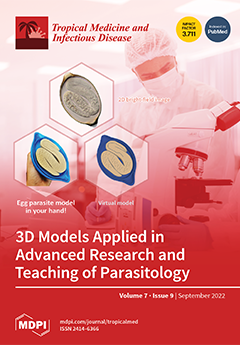Comprehensive data on the relative contribution of bacteremia to malaria outcomes in a large number of participants are lacking. Therefore, we collated data on the co-existence of malaria and bacteremia in the literature to provide evidence-based information for future studies investigating the clinical
[...] Read more.
Comprehensive data on the relative contribution of bacteremia to malaria outcomes in a large number of participants are lacking. Therefore, we collated data on the co-existence of malaria and bacteremia in the literature to provide evidence-based information for future studies investigating the clinical significance of this co-infection. The study protocol was registered at PROSPERO (ID: CRD42021287971). Relevant studies were identified from PubMed, Web of Science, and Scopus. The pooled prevalence of (1) co-existent malaria and bacteremia among febrile patients, (2) the pooled prevalence of bacteremia among patients with malaria, (3) the probability of co-infection, and (4) the pooled prevalence of deaths were estimated by the random-effects model. Fifty-one studies involving 1583 cases of co-infection were included in the analyses. Typhoidal
Salmonella spp. and
Staphylococcus aureus were the most common Gram-negative and Gram-positive bacteria, respectively. The prevalence of co-existent malaria and bacteremia among febrile patients was 1.9% (95% confidence interval (CI) = 1.5–2.2%,
I2 = 96.64%, 31 studies). The prevalence of bacteremia among patients with malaria was 7.6% (95% CI = 6.7–8.7%, and
I2 = 96.68%, 43 studies). Co-infection by malaria and bacteremia did not occur by chance (
p = 0.024, odds ratio = 0.64, 95% CI = 0.43–0.94, and
I2 = 95.7%, 29 studies). The pooled prevalence of deaths among patients with co-infection was 15.0% (95% CI = 8.0–23.0%,
I2 = 75.23%, 8 studies). On the basis of this study, we conclude that although the prevalence of co-infection was low, patients with malaria appear at greater risk of bacteremia and death.
Full article






